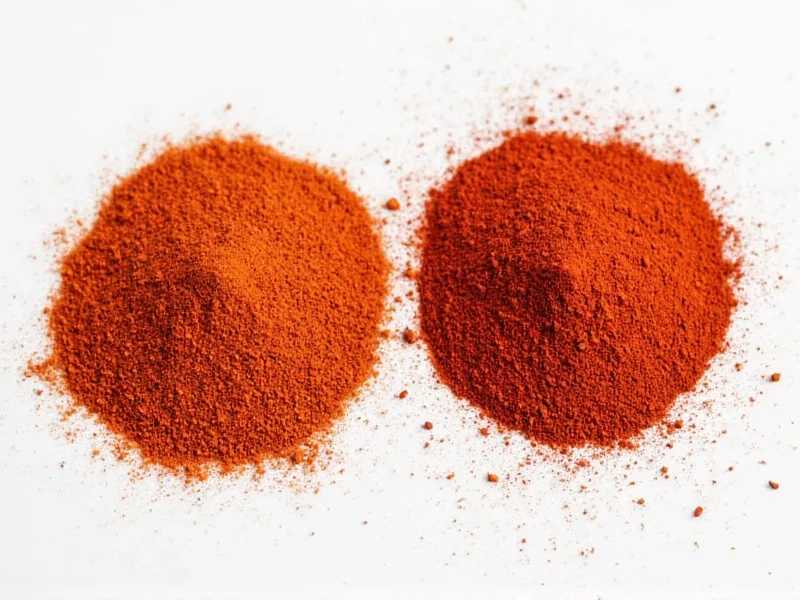Understanding the distinction between crushed red pepper and cayenne is essential for home cooks who want precise control over their dish's heat and flavor profile. While these spices appear similar in color and often sit side by side in pantry collections, their culinary applications differ substantially. This comprehensive guide explores their origins, heat levels, flavor characteristics, and practical substitution guidelines to help you make informed decisions in your cooking.
What Exactly Are These Spices?
Crushed red pepper, often labeled as "red pepper flakes" in stores, consists of coarsely ground dried chili peppers. Most commercial blends contain a mixture of cayenne, ancho, and other red chili varieties, creating a complex flavor profile with varying heat levels. The visible flakes typically include seeds and membrane fragments, which contribute significantly to the heat.
Cayenne pepper, by contrast, refers specifically to a fine powder made from dried cayenne peppers (Capsicum annuum). Authentic cayenne contains only this single chili variety, though some commercial products may include additives like rice flour or salt. The uniform red powder delivers consistent heat without the textural elements found in crushed red pepper.
Comparing Heat and Flavor Profiles
The most critical difference lies in their heat intensity and flavor complexity. Understanding these characteristics helps explain why crushed red pepper vs cayenne matters in recipe execution.
| Characteristic | Crushed Red Pepper | Cayenne Pepper |
|---|---|---|
| Primary Ingredients | Mixture of dried red chilies (often including cayenne, ancho, and others) | 100% ground cayenne peppers |
| Scoville Heat Units | 5,000-25,000 SHU (varies by blend) | 30,000-50,000 SHU (consistent) |
| Texture | Coarse flakes with visible seeds and skin | Fine, uniform powder |
| Flavor Complexity | Bright, slightly fruity with variable heat | Sharp, immediate heat with less complexity |
| Heat Development | Gradual, builds slowly | Immediate, intense burn |
Practical Culinary Applications
Knowing crushed red pepper vs cayenne heat level differences directly impacts how you use them in cooking. Each spice serves distinct purposes based on their physical properties and flavor release characteristics.
Crushed red pepper shines in dishes where texture matters and gradual heat infusion is desirable. Italian cuisine frequently uses it to finish pizzas or sprinkle over pasta dishes, where the flakes provide visual appeal and controlled heat release. The seeds and membranes in the flakes contain capsaicin, so dishes with crushed red pepper often develop heat slowly as they cook or sit.
Cayenne's fine powder form makes it ideal for applications requiring even heat distribution. It dissolves completely in liquids, making it perfect for sauces, soups, and marinades where consistent heat throughout is essential. Many Cajun and Creole recipes specify cayenne because its immediate, intense heat complements the bold flavors of these cuisines. When considering can I substitute crushed red pepper for cayenne, remember that cayenne delivers approximately three times more heat by volume.
Substitution Guidelines You Can Trust
While substitutions are possible in a pinch, understanding the proper conversion ratios prevents ruined dishes. Many home cooks mistakenly treat these spices as identical, leading to unexpectedly mild or painfully hot results.
When substituting crushed red pepper for cayenne, use a 3:1 ratio—three parts crushed red pepper to replace one part cayenne. This accounts for cayenne's significantly higher heat concentration. Conversely, when replacing crushed red pepper with cayenne, use one-third the amount of cayenne to achieve similar heat levels.
Consider the textural element too. If a recipe specifically calls for the visual appeal of red pepper flakes (like on pizza), substituting cayenne will eliminate that characteristic. For dishes where appearance matters, consider adding both a small amount of cayenne for heat and a minimal amount of crushed red pepper for visual texture.
Storage and Shelf Life Considerations
Both spices lose potency over time, but their different physical forms affect how quickly this happens. Proper storage extends their useful life and maintains flavor integrity—critical information often missing from basic crushed red pepper vs cayenne comparisons.
Crushed red pepper's larger surface area causes it to degrade faster than cayenne. Store it in an airtight container away from light and heat, where it maintains peak quality for 6-12 months. The flakes should retain their vibrant red color; fading indicates diminished potency.
Cayenne's fine powder form gives it slightly better shelf stability—typically 12-18 months when stored properly. However, its fine texture makes it more susceptible to moisture absorption, so ensure containers are completely dry before refilling. Both spices should never be stored above the stove or near other heat sources, which accelerate flavor and heat degradation.
Common Misconceptions Clarified
Several persistent myths confuse home cooks about these spices. Understanding these clarifications helps explain is cayenne pepper the same as red pepper flakes—a frequently searched question.
Myth: "Crushed red pepper is just cayenne in flake form." Reality: While many crushed red pepper blends contain cayenne, they typically include multiple chili varieties, creating a more complex flavor profile than pure cayenne.
Myth: "They can be used interchangeably in equal amounts." Reality: Due to cayenne's significantly higher heat concentration, equal substitution often results in dishes that are either too mild or painfully hot.
Myth: "The terms are regional variations for the same product." Reality: These are distinct products with different compositions, heat levels, and culinary applications regardless of geographic location.











 浙公网安备
33010002000092号
浙公网安备
33010002000092号 浙B2-20120091-4
浙B2-20120091-4